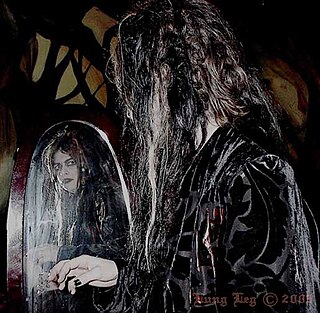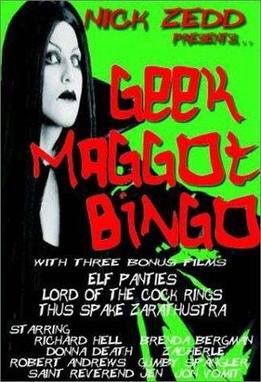Related Research Articles

A cult film or cult movie, also commonly referred to as a cult classic, is a film that has acquired a cult following. Cult films are known for their dedicated, passionate fanbase which forms an elaborate subculture, members of which engage in repeated viewings, dialogue-quoting, and audience participation. Inclusive definitions allow for major studio productions, especially box-office bombs, while exclusive definitions focus more on obscure, transgressive films shunned by the mainstream. The difficulty in defining the term and subjectivity of what qualifies as a cult film mirror classificatory disputes about art. The term cult film itself was first used in the 1970s to describe the culture that surrounded underground films and midnight movies, though cult was in common use in film analysis for decades prior to that.
No wave was an avant-garde music genre and visual art scene which emerged in the late 1970s in Downtown New York City. The term was a pun based on the rejection of commercial new wave music. Reacting against punk rock's recycling of rock and roll clichés, no wave musicians instead experimented with noise, dissonance, and atonality, as well as non-rock genres like free jazz, funk, and disco. The scene often reflected an abrasive, confrontational, and nihilistic world view.
Avant-garde music is music that is considered to be at the forefront of innovation in its field, with the term "avant-garde" implying a critique of existing aesthetic conventions, rejection of the status quo in favor of unique or original elements, and the idea of deliberately challenging or alienating audiences. Avant-garde music may be distinguished from experimental music by the way it adopts an extreme position within a certain tradition, whereas experimental music lies outside tradition.
Richard Kern is an American underground filmmaker, writer and photographer. He first came to prominence as part of the cultural explosion in the East Village of New York City in the 1980s, with erotic and experimental films like The Right Side of My Brain and Fingered, which featured personalities of the time such as Lydia Lunch, David Wojnarowicz, Sonic Youth, Kembra Pfahler, Karen Finley and Henry Rollins. Like many of the musicians around him, Kern had a deep interest in the aesthetics of extreme sex, violence and perversion and was involved in the Cinema of Transgression movement, a term coined by Nick Zedd.

Andres Serrano is an American photographer and artist. His work, often considered transgressive art, includes photos of corpses and uses feces and bodily fluids. His Piss Christ (1987) is an amber-tinged photograph of a crucifix submerged in a glass container of what was purported to be the artist's own urine. He also created the artwork for the heavy metal band Metallica's Load and Reload albums.

James George Thirlwell, styled as JG Thirlwell and also known as Clint Ruin, Frank Want, and Foetus, among other pseudonyms, is an Australian musician, composer, and record producer known for his use of a variety of different musical styles.

Nick Zedd was an American filmmaker, author, and painter based in Mexico City. He coined the term Cinema of Transgression in 1985 to describe a loose-knit group of like-minded filmmakers and artists using shock value and black humor in their work. These filmmakers and artistic collaborators included Richard Kern, Tessa Hughes Freeland, Lung Leg, Kembra Pfahler, and Lydia Lunch. Under numerous pen names, Zedd edited and wrote the Underground Film Bulletin (1984–1990) which publicized the work of these filmmakers. The Cinema of Transgression was explored in Jack Sargeant's book Deathtripping.
An underground film is a film that is out of the mainstream either in its style, genre or financing.
Alternative porn, a shortening of "alternative pornography", is a subgenre of pornography that is centered around alternative subcultures, such as goths, punks, emos, scenes, skaters or ravers, and is often produced by small and independent websites or filmmakers. It often features models with body modifications such as tattoos, piercings, or scarifications or temporary modifications such as dyed hair or extreme makeup. The term indie porn is occasionally used though this term is more generally used as a synonym for independent pornography, regardless of affinity with any kind of alternative subculture.

Lung Leg is an American pin-up girl and actress perhaps best known for appearing on the cover of the Sonic Youth album EVOL. During the 1980s, she gained fame as a model and star of films made by the transgressive movement.
Shock value(or shock factor) is the potential of an image, text, action, or other form of communication, such as a public execution, to provoke a reaction of sharp disgust, shock, anger, fear, or similar negative emotions.
No wave cinema was an underground filmmaking movement that flourished on the Lower East Side of New York City from about 1976 to 1985. Associated with the artists’ group Collaborative Projects, no wave cinema was a stripped-down style of guerrilla filmmaking that emphasized dark edgy mood and unrehearsed immediacy above many other artistic concerns – similar to the parallel no wave music movement in its raw and rapid style.
The Cinema of Transgression is a term coined by Nick Zedd in 1985 to describe a New York City–based underground film movement, consisting of a loose-knit group of artists using shock value and black humor in their films. Key players in this movement were Zedd, Kembra Pfahler, Tessa Hughes-Freeland, Casandra Stark, Beth B, Tommy Turner, Jon Moritsugu, Manuel DeLanda, David Wojnarowicz, Richard Kern, and Lydia Lunch, who in the late 1970s and mid-1980s began to make very low-budget films using cheap 8 mm cameras.

Kembra Pfahler is an American filmmaker, performance artist, visual artist, adjunct professor, rock musician, and film actress.
Gross out is described as a movement in art, which is intended to shock the viewer(s) and disgust the wider audience by presenting them with controversial material that might be ill received by a mainstream audience. The content of the movement is not for the average art appreciatist.

A jukebox musical is a stage musical or musical film in which a majority of the songs are well-known popular music songs, rather than original music.
Ground Zero Gallery was an art gallery formed in the East Village of Manhattan in New York City in mid-1983 as a vehicle for the partnership of artist James Romberger and his co-founder Marguerite Van Cook. In 1984, the gallery found its first physical home on East 11th Street and showed the work of many East Village artists who went on to gain national recognition. It was an early proponent of installation art. Ground Zero was the production name for many projects in various media undertaken by the team of Van Cook and Romberger prior to the September 11 attacks.
First published as Deathtripping: The Cinema of Transgression by Creation Books in 1995 and subsequently republished as Deathtripping: The Extreme Underground by Soft Skull Press, Deathtripping is a book by Jack Sargeant which examines the New York based, post-punk underground film movement known as the Cinema of Transgression that formed around the manifesto written by underground filmmaker Nick Zedd. The loose-knit group of underground filmmakers included Richard Kern, Tommy Turner, Lydia Lunch, Beth B, Cassandra Stark, Joe Coleman and David Wojnarowicz, amongst others.

Geek Maggot Bingo is a 1983 comedy horror film directed by Nick Zedd, who also scripted and shot the film.
Tessa Hughes-Freeland is a British-born experimental film maker, writer living in New York City. Her films have screened internationally in North America, Europe and Australia and in prominent museums and galleries, including the Museum of Modern Art (MOMA); the Museum of Contemporary Art, Los Angeles; the Whitney Museum of American Art; the New Museum of Contemporary Art in New York; and the KW Institute of Contemporary Art in Berlin. She has collaborated on live multi-media projects with musicians like John Zorn and J. G. Thirlwell. She and Ela Troyano co-founded the New York Film Festival Downtown in 1984 and served as its co-directors until 1990. Hughes-Freeland later served as President of the Board of Directors of the Film-Makers Co-Operative in New York City from 1998-2001. She has published articles in numerous books, including “Naked Lens: Beat Cinema” and “No Focus: Punk Film,” and in periodicals including PAPER Magazine, Filmmaker magazine, GQ, the East Village Eye, and Film Threat.
References
- ↑ Shock Value: New York’s underground ‘Cinema of Transgression’-Dangerous Minds
- ↑ Zedd, Nick (1985). "The Cinema of Transgression Manifesto" . Retrieved 7 June 2014.
- ↑ Films by Richard Kern: Program 2 | MoMA
- ↑ Cohen, Alina (2018-07-25). "It's Legal to Burn the American Flag. This Artist Helped Make It A Form of Free Speech". Artsy. Retrieved 2021-05-04.
- ↑ Palmer, Alex. "When Art Fought the Law and the Art Won". Smithsonian Magazine. Retrieved 2021-05-04.
- ↑ Transgressive Art as a Form of Protest-Art News & Views [usurped]
- ↑ By Jeffrey Weiss, Artforum
- ↑ Word Watch — December 1996 from The Atlantic Monthly
- ↑ Joseph Gallivan (30 Oct 2009). "Citizen Goad". Entertainment. Portland Life. Retrieved 3 October 2011.
- ↑ Harvilla, Rob (2019-02-20). "Eminem Has Been America's Nightmare for 20 Years". The Ringer. Retrieved 2024-01-25.
- ↑ Mancini, Robert (September 13, 2000). "Eminem Targeted At Senate Hearing". MTV News. Viacom. Retrieved February 9, 2014.
- ↑ "Transcendence, Transgression, and Rock & Roll: The Music of Luxury - Christ and Pop Culture". Christ and Pop Culture. Retrieved 2017-09-09.